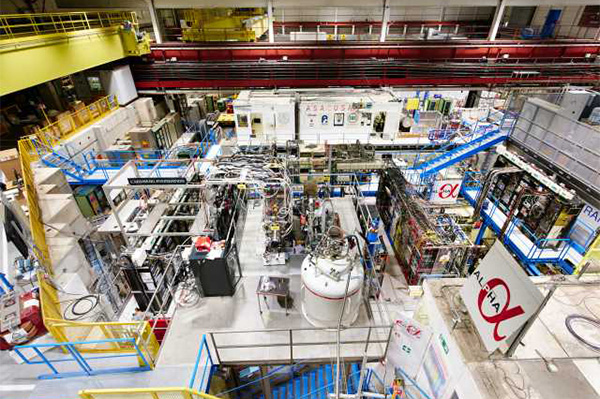Breakthrough in understanding gravitational effects on antimatter

In a paper published today in Nature, the ALPHA collaboration at CERN’s Antimatter Factory shows that, within the precision of their experiment, atoms of antihydrogen – a positron orbiting an antiproton – fall to Earth in the same way as their matter equivalents.
Einstein’s general theory of relativity described the effects of gravity in 1915 and has passed many experimental tests since then. A component of the theory called the weak equivalence principle states that all objects, regardless of their mass or composition, should experience exactly the same gravitational acceleration. Although the prevailing view is that antimatter should behave in the same way as matter in response to Earth’s gravitational pull, it has been extremely difficult to test whether this is true because antimatter annihilates whenever it meets its opposite particle.
The ALPHA collaboration creates antihydrogen atoms by taking negatively charged antiprotons, produced and slowed down in the Antimatter Factory’s AD and ELENA machines, and binding them with positively charged positrons accumulated from a sodium-22 source.
In 2018 the ALPHA collaboration from CERN constructed the ALPHA-g machine, a magnetic trap for antihydrogen atoms, designed to study the effects of gravitation. It confines the neutral – but slightly magnetic – antimatter atoms, which prevents them from coming into contact with matter and annihilating.
This machine makes it possible to measure the vertical positions at which the antihydrogen atoms annihilate with matter once the trap’s magnetic field is switched off, allowing the atoms to escape.
In their investigations the ALPHA researchers slowly released antihydrogen atoms suspended within the ALPHA-g machine and tracked their subsequent motion. If more spill out of the bottom than the top it is likely that antimatter atoms behave in the same way as regular matter. With this experiment, Jeffrey Hangst and colleagues observed a tendency for magnetically trapped antihydrogen atoms released into ALPHA-g to fall from the bottom of the apparatus.
These findings confirm the prevailing view that antimatter should feel the effects of gravity the same way as for ordinary matter, in agreement with the predictions of general relativity. The work paves the way for future tests of the weak equivalence principle, which may improve our understanding of the gravitational nature of antimatter, the authors conclude.
Full article:
Anderson, E.K., Baker, C.J., Bertsche, W. et al. Observation of the effect of gravity on the motion of antimatter. Nature 621, 716–722 (2023). https://doi.org/10.1038/s41586-023-06527-1
Further information:
https://home.cern/news/news/physics/alpha-experiment-cern-observes-influence-gravity-antimatter
https://www.nature.com/articles/d41586-023-03043-0
Video news release: